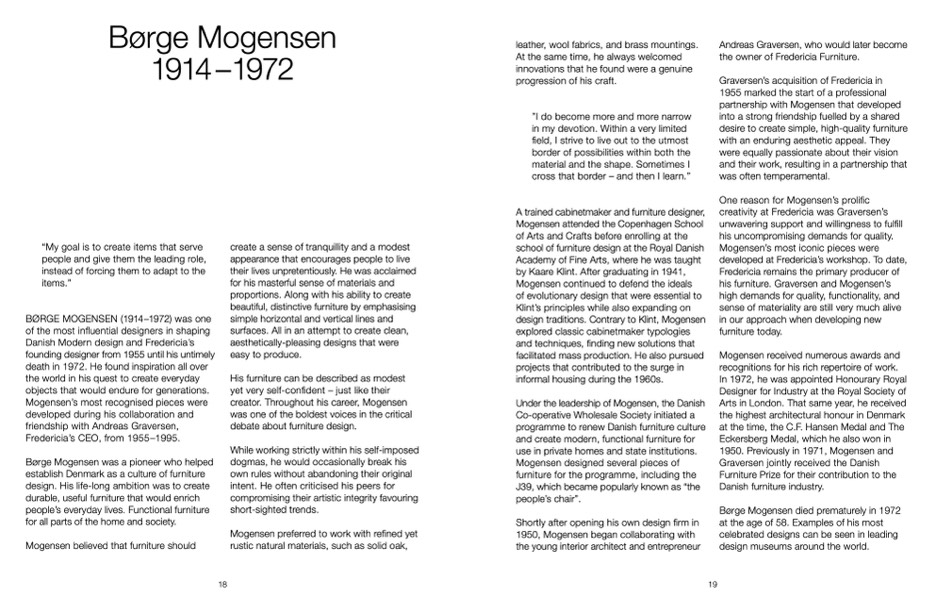
Børge Mogensen
1914 –1972
leather, wool fabrics, and brass mountings.
At the same time, he always welcomed
innovations that he found were a genuine
progression of his craft.
”I do become more and more narrow
in my devotion. Within a very limited
field, I strive to live out to the utmost
border of possibilities within both the
material and the shape. Sometimes I
cross that border – and then I learn.”
A trained cabinetmaker and furniture designer,
Mogensen attended the Copenhagen School
of Arts and Crafts before enrolling at the
school of furniture design at the Royal Danish
Academy of Fine Arts, where he was taught
by Kaare Klint. After graduating in 1941,
Mogensen continued to defend the ideals
of evolutionary design that were essential to
Klint’s principles while also expanding on
design traditions. Contrary to Klint, Mogensen
explored classic cabinetmaker typologies
and techniques, finding new solutions that
facilitated mass production. He also pursued
projects that contributed to the surge in
informal housing during the 1960s.
Under the leadership of Mogensen, the Danish
Co-operative Wholesale Society initiated a
programme to renew Danish furniture culture
and create modern, functional furniture for
use in private homes and state institutions.
Mogensen designed several pieces of
furniture for the programme, including the
J39, which became popularly known as “the
people’s chair”.
Shortly after opening his own design firm in
1950, Mogensen began collaborating with
the young interior architect and entrepreneur
Andreas Graversen, who would later become
the owner of Fredericia Furniture.
Graversen’s acquisition of Fredericia in
1955 marked the start of a professional
partnership with Mogensen that developed
into a strong friendship fuelled by a shared
desire to create simple, high-quality furniture
with an enduring aesthetic appeal. They
were equally passionate about their vision
and their work, resulting in a partnership that
was often temperamental.
One reason for Mogensen’s prolific
creativity at Fredericia was Graversen’s
unwavering support and willingness to fulfill
his uncompromising demands for quality.
Mogensen’s most iconic pieces were
developed at Fredericia’s workshop. To date,
Fredericia remains the primary producer of
his furniture. Graversen and Mogensen’s
high demands for quality, functionality, and
sense of materiality are still very much alive
in our approach when developing new
furniture today.
Mogensen received numerous awards and
recognitions for his rich repertoire of work.
In 1972, he was appointed Honourary Royal
Designer for Industry at the Royal Society of
Arts in London. That same year, he received
the highest architectural honour in Denmark
at the time, the C.F. Hansen Medal and The
Eckersberg Medal, which he also won in
1950. Previously in 1971, Mogensen and
Graversen jointly received the Danish
Furniture Prize for their contribution to the
Danish furniture industry.
Børge Mogensen died prematurely in 1972
at the age of 58. Examples of his most
celebrated designs can be seen in leading
design museums around the world.
“My goal is to create items that serve
people and give them the leading role,
instead of forcing them to adapt to the
items.”
BØRGE MOGENSEN (1914–1972) was one
of the most influential designers in shaping
Danish Modern design and Fredericia’s
founding designer from 1955 until his untimely
death in 1972. He found inspiration all over
the world in his quest to create everyday
objects that would endure for generations.
Mogensen’s most recognised pieces were
developed during his collaboration and
friendship with Andreas Graversen,
Fredericia’s CEO, from 1955–1995.
Børge Mogensen was a pioneer who helped
establish Denmark as a culture of furniture
design. His life-long ambition was to create
durable, useful furniture that would enrich
people’s everyday lives. Functional furniture
for all parts of the home and society.
Mogensen believed that furniture should
18
create a sense of tranquillity and a modest
appearance that encourages people to live
their lives unpretentiously. He was acclaimed
for his masterful sense of materials and
proportions. Along with his ability to create
beautiful, distinctive furniture by emphasising
simple horizontal and vertical lines and
surfaces. All in an attempt to create clean,
aesthetically-pleasing designs that were
easy to produce.
His furniture can be described as modest
yet very self-confident – just like their
creator. Throughout his career, Mogensen
was one of the boldest voices in the critical
debate about furniture design.
While working strictly within his self-imposed
dogmas, he would occasionally break his
own rules without abandoning their original
intent. He often criticised his peers for
compromising their artistic integrity favouring
short-sighted trends.
Mogensen preferred to work with refined yet
rustic natural materials, such as solid oak,
19

